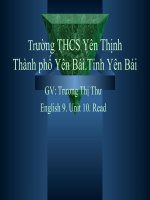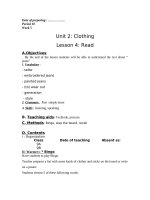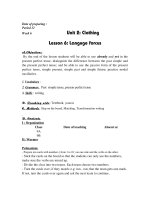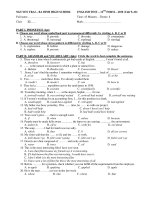ENGLISH 9 PERIOD 9 10
Bạn đang xem bản rút gọn của tài liệu. Xem và tải ngay bản đầy đủ của tài liệu tại đây (160.01 KB, 19 trang )
Date of planning 01/10/2021
Period: 10
Unit 2 –CLOTHING
LESSON :4- READ
A.Objectives:
1.The aims
By the end of the lesson, ss will be able to read a passage to get specific
and detailed information about jeans.
-Knowleges:
+ Standard : Read and know about jeans: material, strength, price,
convenience, fashions
+ Higher :
Tell about the developments of jeans through the years
- Language contents:
a.Vocabulary: cotton, wear out, be made from, embroidered, sale, out of
fashion, go up, get worse,
b.Structures : past simple, the passive, present ferfect
2.Skills
+ Reading : Drill reading comprehension skills to get specific and
detailedinformation about jeans
+ Writing : Write the correct questions and answers about jeans in the
book
3. Attitude: Educate ss to learn hard and to know the way to wear suitably
and fashionably
B. Techniques: -Asking and answering; Guessing games; Cross-word; What
and where ,Net-work
C. Teaching aids:- Student Palmtop, Teacher’s cards and pictures about the garments
of some countries in the world.
D. Procedures:
I.Organization(1’)
Class Date of teaching
Absent students
9C
04/10/2021
II. check the old lesson (5’)
New words, exercises
III.New lesson
Teacher’s and students’ activities:
Contents:
-T. lets Ss play the games.
- Ss play the games.
-T. guides Ss how to play the games.
-Ss. Go to the board and write words
on the board.
- Others crossing-check and remark.
-T. may supply some difficult words.
*Warm up (5’):
Net-work:
Trousers
Jea
Garments
Or Clothes
ns
-T. lets Ss choose the voc.
-SS. Choose the voc and give the
meaning.
-T. presents voc and explains the voc.
-Ss. Guess the meaning and
pronunciation the words.
-T. explains how to pronoun the voc.
- Ss. Listen to the student Palmtop.
And repeat after to the teacher.
-T. corrects Ss pronoun voc
-Ss listen and copy the voc
-T. lets Ss play the games.
-Ss. Play the games
-T. Writes each word in a callout on
the board. Practice saying the words, rub
out the words one - by - one.
-T.Gets students to repeat the words
including the rubbed out ones.
Students try to remember all the
words
-T. Ask students the question:
- Ask students to read the text to find out
the answers to their questions and add
more ideas.
- Ask students to read the text to fill
Step 1. Pre-Reading :(7’):
- Vocabulary:
material (translation): chat lieu,
nguyen lieu
cotton (realia): bông, sợi bông
(to) wear out (realia or explanation): use
something so much that it no longer
works, or can no longer be used): lam rach
style (picture): kieu dang
(to) embroider ( realia):theu (hoa van,
hinh...)
(a) label (realia): nhan, nhãn hiệu
- Checking vocabulary: What and
Where
in the missing dates and words,
exercise a), on page 17
-T. Has students work in pairs to
answer the questions (exercise b) on
page 18).
-Ss . Give feedback.
- Ss. Ask and answer the questions.
-Ss . go to the board and write their
answers.
-T.lets Ss crossing-check and remark.
- T. gives the correct answers.
-Ss. Consult and copy.
- T. lets some strong Ss reread and
translate into vietnamese
Step2. While –Reading (15’):
( Now you read the text and fill the missing
dates and words)
Brainstorming:
Make questions. Elicit questions from
students:
• Who first designed jeans?
• When did jeans become
popular? / Why?
• Where were jeans made? • What
were jeans made of?
What are some famous jeans
designers?
* Answers:
1.18th centery ........Jeans
cloth.............................
-T. lets Ss discuss the questions .
2.1960s..............Students.............................
-Ss. Base on the questions then ask and ......................
answer.
3.1970s ........ cheaper........
-Ss . play the role.
4.1980s........
fashion........
-Ss. Work in pairs.
5.1990 ........
sale ........
-T. guides Ss how to ask and answer.
Questions and answers:
-T. remarks and gives them marks.
1. Where does the word jeans come
-Ss. Crossing-check and copy the
from?
correct keys.
The word “jeans” comes from a kind of
material that was made in Europe.
2. What was the 60s' fashions?
The 60s' fashions were embroidered
-
jeans, painted jeans and so on.
3. Why did more and more people
begin wearing jeans in the 1970s? Because
jeans became cheaper.
4. When did jeans at last become high
fashion clothing?
Jeans at last became high fashion
clothing in the 1980s.
5. Why did the sale of jeans stop
growing?
T. Gets students work in pairs to find the The sale of jeans stopped growing
words.
because the worldwide economic
- T.Divides the class into two teams,
situation got worse in the 1990s.
students from each team goes to the board Step 3. Post-Reading: (8’):
and circle the words they have found then - Discussion:
write them down in the column of their
- Have students work in groups to
team. The team which has more words
discuss
will win the game.
the questions
- Ss. Present their keys.
1. Do you like wearing jeans?
-T. lets Ss crossing-check.
Why? Why not?
-Ss. Copy the keys into their notebooks.
2. What type of jeans do you love
- T. comments and gives them marks
wearing?
- Ss. Consult and copy.
3. Do you think Jeans are in
fashion?
Students’ answering: ( marks)
Cross-word :
AT P L A I N B D F
DR E S S Z L P WQ
P I O I K O Y AMX
.
HH B L U E R NV L
AS H S WE A T E S
T T R O U S E R S H
I H MO B A G GY I
GS T R I P E DJ R
HI WT J E A NS T
T K B S H O O S E S
Keys: cross: PLAIN; DRESS;
BLUE;TROUSERS;
SWEATER;BAG; JEANS;SHOOSES;
STRIPED
Keys down: blouse; hat;tight;
shorts;shirt
IV.Consolidation(2’)
T. reminds Ss the voc and the structures.
V. Homework (2’):
-Learn by heart all voc and grammar points.
-Describe the fashion that you like best
-Do exercises in the work book page 16-17.-18
-Try to use 8 tenses in English and write grammar points and voc in your
notebook ten times
-Prepare next period write
*Evaluation:
……………………………………………………………………………………
……………………………………………………………………………………
……………………………………………………………………………………
……………………………………………………………………………………
……………………………………………………………………………………
Date of planning:01/10/2021
Period: 11th
UNIT 2 –CLOTHING
LESSON :4- LANGUAGE FOCUS 1,2,3
A.The objectives
1. The aims :
By the end of the lesson, ss will have a good chance to review
The present perfect tense ( irregular verbs)
The passive
-Knowleges:
+ Standard: Make up dialogues using the present perfect tense and the given
information
Ask and answer the questions using the present perfect tense
and the given information
Write sentences using the sentences, the given words and the
passive
+ Higher : Freely ask and answer the questions using the present perfect
tense
Write sentences about the things in their family or school using
the passive
- Language contents:
a.Vocabulary: review all vocabulary
b.Structures : Present perfect and the passive ( irregular verbs ).
2,Skills :
+ Speaking and writing skills
3. Attitude: Educate ss to learn hard and to be friendly, look up to their
friendship
B. Techniques: -Asking and answering; Pelmanism; Cross-word; Rub out and
remember.
C. Teaching aids: - Student Palmtop, Teacher’s cards and pictures about the
garments.
D. Procedures:
I.Organization(1’)
Class Date of teaching
Absent students
9C
05/10/2021
II. check the old lesson (5’)
New words, exercises
III.New lesson
Teacher’s and Students’ activities:
-T. lets Ss play the games.
-T. guides Ss how to play the games.
-T. Prepares ten cards
with numbers (from
1to10) on one side and the
verbs on the other.
-T. sticks the cards on
the board so that the
students can only see the
numbers, make sure the
verbs are mixed up.
-T. Divides the class into
two teams.
-Ss work in groups: Each
team
chooses
two
numbers.
-T. Sets the scene:
-Ss. Listen and practice.
-T. guides Ss how to use the present
perfect.
-Ss. Listen and go the board write the
structures on the board.
-T. reminds how to use for and since.
-Ss. Practice the dia in pairs.
-T. gives the keys.
-Ss. Consult and copy.
-T. lets some strong Ss translate the
Content:
*Warm up (5’)
- Pelmanism:
- Turn the cards over, if they match:
e.g. run- ran; that team gets one mark.
- If not, turn the cards over again and
ask the next team to continue.
- Go on until all the cards are turned
over. The team which has more marks
will win the game.
Do
Went
visited
go
saw
eat
1. Activity 1 :(8’)
(Now you use the information in the
box and make similar dialogues.)
Present perfect tense. S + Have/Has +
PP or (V-ed) + for or since:
For: a period of the time.
Scince: a point of time.
Keys:
b)
A: Lien, come here and see my
photo album.
B: Oh, so beautiful! Who's this boy?
A: It's Quaiig, my brother'sfriend.
B: How long have you known him?
A: I 've known him for seven months.
B: Have you seen him recently?
A: No, I haven't seen him since
January.
dia.
C)
A: Come and see my photo album.
B: Lovely! Who's this girl?
A: It's Hoa, my new friend.
-T. Asks students to look at the dialogue: B: How long have you known her?
A: I 've known her for three weeks.
B: Have you seen her recently?
A: I haven't seen her since Monday.
-T. Asks students to practice the
dialogue in pairs
-T. Sets the scene:
- Ask students to look at the dialogue.
-T. guides Ss how to use the present
perfect.
-Ss. Listen and go the board write the
structures on the board.
-T. reminds how to use already and
yet.
-Ss. Practice the dia in pairs.
-T. gives the keys.
-Ss. Consult and copy.
-T. lets some strong Ss translate the
2. Activity : 2 (7’):
The present perfect I. Review the
present perfect with ALREADY
& YET
(Now you use the information in the
box and make similar dialogues.)
- You and your friend are visiting Ho
Chi Minh City. Lookat the notes,
there are things you have done, and
some things you haven't done,
what are they?
- Elicit from students.
I have seen Giac Lam Pagoda.
I have eaten Chinese and French food.
I haven't seen Unification Palace,
Zoo and
Botanical Garden, I haven't tried
Vietnam vegetarian
A: Have you seen the Giac Lam Pagoda
yet?
B: Yes, I've already seen it.
A: Have you eaten Campodian food yet?
B: No, I haven't.
- Elicit from students the use and the
position of already and yet in the
sentence.
ARE AD Y is used in affirmative
sentences.
dia.
Position: mid sentence
YET is used in the negative sentences
and questions
Position: end of the sentence
A:- Have you ever been America yet?
B: No, I have n’t.
Examples:
A:Have you seen the Reunification
Palace yet?
B:No, I haven't.
Teacher goes round the class to takes
notes mistakes students have made for
the delayed correction.
4.Actyvity 3(7’):
II. Review present perfect with
EVER
Tom and Mary are talking to each
other about places they have been to.
Tom: Have you ever been to Ireland?
Mary: No, I haven't.
Tom: Have you ever been to France?
Mary: Yes, I have.
Tom: When did you go there?
- Students work in pairs to practice
Mary: Two years ago.
asking and answering about each of the
- Elicit from the students:
items in the box.
+ We use the past simple to talk
about definite time.
e.g. I went to France last year / two
months
-T. guides Ss how to use the present
ago/ i n 1992
perfect.
+ We use the present perfect to talk
-Ss. Listen and go the board write the
about
structures on the board.
indefinite past time.
-T. reminds how to use ever .
e.g. Have you ever ( at some time in
-Ss. Practice the dia in pairs.
your
-T. gives the keys.
life) been to Italy?
-Ss. Consult and copy.
EVER : is used in questions
-T. lets some strong Ss translate the
dia.
-T. guides Ss how to recognize the
perfect tense.
-Ss. Listen and copy.
-Ss. Base on the structures and do the
same dia.
-Ss. Practice in pairs
-T. corrects and gives them marks.
-Ss. Crossing-check.
Meaning: co bao gio"
- Run through the vocabulary in
exercise 3 on page 20.
Read a comic Go Use a computer
to the market Go Play volleyball Go
to Singapore See to the movies Eat
an
elephant
durian
Example
A: Have you ever read a comic?
B: Yes, I have.
A
Have you ever studied a
language before?
B
Yes, I have.
A
Oh, which one did you study?
B
I studied French at school. *
Marks: (10ms)
...................
G
Have you ever drunk too
much?
H
Yes... I have.
G
Where did you drink too
much?
H
I drank too much at my
brother's wedding.
-T. lets Ss remind the structure of the
Passive voice.
-Ss go to the board and write them on.
-T. reminds how to change the
Subject and Object.
-Ss. Listen and copy.
-T. lets Ss base on the structures and
do the same.
-Ss. Practice.
-T. lets Ss crossing-check.
-Ss.consult and crossing check.
-Ss. Listn to the T’s explainations.
-Ss. Copy
-T reminds how to use modal verbs
and how to change the opposite voice.
- Ss. Listen and copy .
-Ss. Base on the explainations and do
the same.
-T. lets Ss go to the board and present
their keys.
-T. gives the correct answers Ss .
consult and copy.
-Ss. Crossing-check and copy the
keys.
IV.Consolidation(2’)
-T. reminds Ss the voc and the structures.
V. Home work : (2’)
- Write the questions and answers into your exercise books.
-learn by heart voc and the structure of the present perfect tense.-S+
Have/Has + PP : I have lost my key. Simple past: S + V(past tense or Ved) :
-Learn Passive voice: Modal verb + be + Pn
Have to/Be going to + be + Pn.
*Evaluation:
………………….
…………………………………………………………………….
………………….
…………………………………………………………………….
………………….
…………………………………………………………………….
………………….
…………………………………………………………………….
………………….
…………………………………………………………………….
………………….
…………………………………………………………………….
****************************
Date of planning:27/09/2018
Period: 12th
UNIT 2 –CLOTHING
LESSON :6- LANGUAGE FOCUS
A.The objectives
1. The aims :
By the end of the lesson, ss will have a good chance to review
The present perfect tense ( irregular verbs)
The passive
2,Skills :
+ Speaking and writing skills
3.Knowleges:
+ Standard: Make up dialogues using the present perfect tense and the given
information
Ask and answer the questions using the present perfect tense
and the given information
Write sentences using the sentences, the given words and the
passive
+ Higher : Freely ask and answer the questions using the present perfect
tense
Write sentences about the things in their family or school using
the passive
4. Language contents:
a.Vocabulary: review all vocabulary
b.Structures : Present perfect and the passive ( irregular verbs ).
5. Attitude: Educate ss to learn hard and to be friendly, look up to their
friendship
B. Techniques: -Asking and answering; Pelmanism; Cross-word; Rub out and
remember.
C. Teaching aids: - Student Palmtop, Teacher’s cards and pictures about the
garments.
D. Procedures:
I.Organization(1’)
Class Date of teaching
Absent students
9A
9B
II. check the old lesson (5’)
New words, exercises
III.New lesson
Teacher’s and Students’ activities:
-T. lets Ss play the games.
-T. guides Ss how to play the games.
-T. Prepares ten cards
with numbers (from
1to10) on one side and the
verbs on the other.
-T. sticks the cards on
the board so that the
students can only see the
numbers, make sure the
verbs are mixed up.
Content:
*Warm up (5’)
- Pelmanism:
- Turn the cards over, if they match:
e.g. run- ran; that team gets one mark.
- If not, turn the cards over again and
ask the next team to continue.
- Go on until all the cards are turned
over. The team which has more marks
will win the game.
Do
Went
visited
-T. Divides the class into
two teams.
-Ss work in groups: Each
team
chooses
two
numbers.
-T. Sets the scene:
-Ss. Listen and practice.
-T. guides Ss how to use the present
perfect.
-Ss. Listen and go the board write the
structures on the board.
-T. reminds how to use for and since.
-Ss. Practice the dia in pairs.
-T. gives the keys.
-Ss. Consult and copy.
-T. lets some strong Ss translate the
dia.
go
saw
eat
3. Activity 1 :(8’)
(Now you use the information in the
box and make similar dialogues.)
Present perfect tense. S + Have/Has +
PP or (V-ed) + for or since:
For: a period of the time.
Scince: a point of time.
Keys:
b)
A: Lien, come here and see my
photo album.
B: Oh, so beautiful! Who's this boy?
A: It's Quaiig, my brother'sfriend.
B: How long have you known him?
A: I 've known him for seven months.
B: Have you seen him recently?
A: No, I haven't seen him since
January.
C)
A: Come and see my photo album.
B: Lovely! Who's this girl?
A: It's Hoa, my new friend.
-T. Asks students to look at the dialogue: B: How long have you known her?
A: I 've known her for three weeks.
B: Have you seen her recently?
A: I haven't seen her since Monday.
-T. Asks students to practice the
dialogue in pairs
4. Activity : 2 (7’):
The present perfect I. Review the
present perfect with ALREADY
& YET
(Now you use the information in the
box and make similar dialogues.)
- You and your friend are visiting Ho
-T. Sets the scene:
- Ask students to look at the dialogue.
-T. guides Ss how to use the present
perfect.
-Ss. Listen and go the board write the
structures on the board.
-T. reminds how to use already and
yet.
-Ss. Practice the dia in pairs.
-T. gives the keys.
-Ss. Consult and copy.
-T. lets some strong Ss translate the
dia.
Chi Minh City. Lookat the notes,
there are things you have done, and
some things you haven't done,
what are they?
- Elicit from students.
I have seen Giac Lam Pagoda.
I have eaten Chinese and French food.
I haven't seen Unification Palace,
Zoo and
Botanical Garden, I haven't tried
Vietnam vegetarian
A: Have you seen the Giac Lam Pagoda
yet?
B: Yes, I've already seen it.
A: Have you eaten Campodian food yet?
B: No, I haven't.
- Elicit from students the use and the
position of already and yet in the
sentence.
ARE AD Y is used in affirmative
sentences.
Position: mid sentence
YET is used in the negative sentences
and questions
Position: end of the sentence
A:- Have you ever been America yet?
B: No, I have n’t.
Examples:
A:Have you seen the Reunification
Palace yet?
B:No, I haven't.
Teacher goes round the class to takes
notes mistakes students have made for
the delayed correction.
4.Actyvity 3(7’):
II. Review present perfect with
EVER
Tom and Mary are talking to each
other about places they have been to.
Tom: Have you ever been to Ireland?
Mary: No, I haven't.
Tom: Have you ever been to France?
Mary: Yes, I have.
- Students work in pairs to practice
Tom: When did you go there?
asking and answering about each of the Mary: Two years ago.
items in the box.
- Elicit from the students:
+ We use the past simple to talk
about definite time.
e.g. I went to France last year / two
-T. guides Ss how to use the present
months
perfect.
ago/ i n 1992
-Ss. Listen and go the board write the + We use the present perfect to talk
structures on the board.
about
-T. reminds how to use ever .
indefinite past time.
-Ss. Practice the dia in pairs.
e.g. Have you ever ( at some time in
-T. gives the keys.
your
-Ss. Consult and copy.
life) been to Italy?
-T. lets some strong Ss translate the
EVER : is used in questions
dia.
Meaning: co bao gio"
-T. guides Ss how to recognize the
perfect tense.
-Ss. Listen and copy.
-Ss. Base on the structures and do the
same dia.
-Ss. Practice in pairs
-T. corrects and gives them marks.
-Ss. Crossing-check.
- Run through the vocabulary in
exercise 3 on page 20.
Read a comic Go Use a computer
to the market Go Play volleyball Go
to Singapore See to the movies Eat
an
elephant
durian
Example
A: Have you ever read a comic?
B: Yes, I have.
A
Have you ever studied a
language before?
B
Yes, I have.
A
Oh, which one did you study?
B
I studied French at school. *
Marks: (10ms)
...................
G
Have you ever drunk too
much?
H
Yes... I have.
G
Where did you drink too
much?
H
I drank too much at my
brother's wedding.
5. Activity 4 (8’):
Passive voice:
S + Be + PP
a) Jeans cloth was made completely
from cotton on the 18'1' century.
b) Rice is grown in tropical countries.
c) Five million bottles of champagne
will be produced in France next
year.
-T. lets Ss remind the structure of the
Passive voice.
-Ss go to the board and write them on.
-T. reminds how to change the
Subject and Object.
-Ss. Listen and copy.
-T. lets Ss base on the structures and
do the same.
-Ss. Practice.
-T. lets Ss crossing-check.
-Ss.consult and crossing check.
-Ss. Listn to the T’s explainations.
-Ss. Copy
d) A new style of jeans has just
been introduced in the USA.
e) Two department stores have been
built this year.
passive with modal verbs) and the
structure have to/be going to:
Modal verb + be + Pn
Have to/Be going to + be + Pn
VD: This exercise can be done easily.
The date of the meeting has to be
changed again.
Change the opposite voice:
-Use Ipad
Keys:
a ) The problem can be solved.
b) Exerpiments on animals should be
stopped.
c) Life might be found on another
planet.
d) All the schools in the city have to
be improved.
e) A new bridge is going to be built in
the area.
-T reminds how to use modal verbs
-Do all the exercises in the work book
and how to change the opposite voice. unit 1& 2.
- Ss. Listen and copy .
-Ss. Base on the explainations and do
the same.
-T. lets Ss go to the board and present
their keys.
-T. gives the correct answers Ss .
consult and copy.
-Ss. Crossing-check and copy the
keys.
IV.Consolidation(2’)
-T. reminds Ss the voc and the structures.
V. Home work : (2’)
- Write the questions and answers into your exercise books.
-learn by heart voc and the structure of the present perfect tense.-S+
Have/Has + PP : I have lost my key. Simple past: S + V(past tense or Ved) :
-Learn Passive voice: Modal verb + be + Pn
Have to/Be going to + be + Pn.
*Evaluation:
………………….
…………………………………………………………………….
………………….
…………………………………………………………………….
………………….
…………………………………………………………………….
………………….
…………………………………………………………………….
………………….
…………………………………………………………………….
………………….
…………………………………………………………………….
****************************









